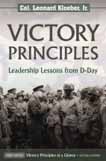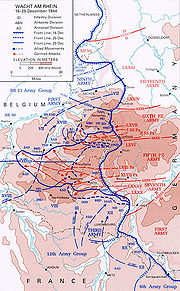Archive for the ‘Montgomery’ tag
December 1944 -Winter in the Bulge
Near the end of the Normandy Campaign on August 15, 1944, the Allies launched another assault through southern France, code named Operation Dragoon. Originally this was planned to be a concurrent operation with the Normandy landings so as to be mutually supporting; however, due to a shortage of available shipping, General Eisenhower reluctantly postponed Operation Dragoon until August. Although Dragoon was slightly smaller in size and scope than Operation Overlord in Normandy, the Allies still landed a formidable force of almost 100,000 soldiers and over 10,000 vehicles on the first day alone. After overcoming initial resistance, the Allies continued to bring in more men and supplies, and opened the major port of Marseilles. These port facilities were needed not only to support the additional troops for Dragoon, but to supply the entire Allied force on the Western Front. Both of the Allied armies from Overlord and Dragoon eventually linked up in mid-September near Dijion, France, as they continued to press their retreating German adversaries across the entire length of Western Europe.
Also in September, General Eisenhower authorized British General Montgomery to conduct Operation Market Garden which was intended to be a lighting strike through Holland and into Germany across the Rhine River. His plan was to use three airborne divisions to seize critical bridges in Holland which would be used by an armored force thrusting from the Belgium border across Holland and into Germany by crossing the Lower Rhine River at Arnhem. The two pronged Market-Garden plan was given priority for supplies and logistics among other Allied operations. This infuriated other American commanders, particularly General Bradley and General Patton who had to restrain his Third Army and conduct only limited attacks further south in France while Market-Garden was in progress.
The Market-Garden battle did not unfold as Montgomery had planned: Most of the bridges were seized after heroic action by the paratroopers, except for the last one at Arnhem over the Rhine as the armored columns were delayed along the way. Consequently, the Allies got mired in Holland instead of making it into Germany. The British paratroopers could not hold onto the Arnhem bridge until relieved and sustained many casualties until they were ordered to withdraw those who could still make it back to rejoin the Allied line. From then on the phrase “a bridge too far” was born to explain what happened, and this phrase is now commonly used to describe stretch goals which are unlikely to be achieved in whatever the endeavor.
Yet despite the disappointment in Operation Market-Garden, the German army had been taking horrendous losses on both the Western and Eastern Fronts as well as in Italy. Thus, many observers and soldiers alike were envisioning a quick Allied victory and some even predicted that hostilities would end by December, but this also was not to be so. Hitler had been planning his own major thrust through the Ardennes Forest to knock the momentum out of the Allied advance and split their force in two by launching a blitzkrieg strike from lower Belgium into the Allied line towards the North Sea port of Antwerp on the coast. He hoped that if he could succeed, he might be able to get the Western Allies to agree to a separate peace accord so that he could focus his attention on the Red Army in the east. So, in October and November, the Germans began massing their panzer forces for a December attack through the Ardennes where the Allies had considered it to be unlikely that the Germans would be able to conduct offensive operations. The Germans were counting on the element of surprise in addition to a swift advance, and if everything went their way, the winter weather conditions would limit the Allies from using their vastly superior air forces.
Initially the Germans got lucky, and their attack, which began with a massive artillery barrage on December 16th, was soon followed up with a blitz by their panzer units. They pushed through the American lines where Eisenhower has posted a mixed group of new units, and combat hardened units that were recuperating on what was considered the “quiet front.” The resulting German advance created “bulge” in the Allied line and hence the largest battle on the Western Front ,and the largest for American forces in any theater of WWII, would be known thereafter as the “Battle of the Bulge.” While the combat experienced units put up a valiant defense in the face of overwhelming German forces, the inexperienced units mostly fell back in disarray and many soldiers were taken as POWs in front of the advancing Germans.
Eisenhower quickly moved into the breach some of his experienced units that were being held in reserve including the paratroopers from the American 82nd and 101st Airborne divisions, but they were not equipped for winter warfare and were short on ammunition and supplies. The 101st was sent to the town of Bastogne where there was a junction of the main roads that ran through the area. If this town could be held, then it would likely stall the German advance and buy time for additional Allied forces to be brought into the fight.
While the paratroopers who were supported by some available armor units from the American 10th Armored Division dug in around Bastogne, Eisenhower called a conference with his major commanders to deal with the situation. As the Germans had hoped, the weather kept the Allied aircraft on the ground, and they were able to maneuver more freely such that they surrounded the pocket around Bastogne by December 21st. At the Allied commander’s conference, General Patton announced that he could redirect elements of his Third Army that were positioned to the south of the pocket to begin an attack north within 48 hours much to the surprise of the other senior commanders. The Allied commanders then set forth to counter-attack the Germans from the south with Patton’s Third Army and also from north with a combined American and British effort forming a pincer to cut off the German advance and relieve Bastogne. They planned to turn the unexpected crisis into an opportunity to defeat the Germans who were now mired in the bulge without supplies and reinforcements of their own.
As promised, Patton began his advance north towards Bastogne, but the northern force did not begin simultaneously because General Montgomery, who was generally a more cautious commander, wanted more time to prepare his units. This was also controversial since Eisenhower had placed the American First and Ninth Armies, a part of Bradley’s command, under Montgomery because the bulge had cut them off from Bradley’s HQ. It was primarily the Americans who would also attack from the north, and not the British. Meanwhile the Germans had sent an ultimatum message requesting the US commander in Bastogne to surrender his forces or be destroyed. Despite the dreadful conditions and shortages of ammunition and food, General Anthony McAuliffe, acting commander of the 101st Airborne answered with a one word reply – “nuts!” As the weather conditions improved on December 23rd the Allied air forces were able to attack the German panzer formations and provide limited supplies by air to the embattled forces in Bastogne. The improved weather conditions also allowed the Third Army to continued their attack, and they eventually reached Bastogne by December 26th bringing additional supplies and evacuating the wounded.
A frustrated Eisenhower urged Montgomery to finally commence his attack from the north on January 1st 1945, however, Montgomery did not get going until January 3rd due to another snowstorm. Nevertheless, the British and American forces in the north had played an important part in the battle by thwarting the German advance towards their primary objective, Antwerp, and now that they began their counter-attack, the Germans were forced to pull back to their original lines – but leaving most of their armor and heavy equipment behind. Just as had happened in Normandy, the Allies had failed to fully shut the back door on the retreating German army, but they had substantially depleted their ability to conduct any more offensive operations having suffered estimated 80 – 100,000 casualties and losses of critical equipment. Although the Americans had also suffered a similar loss, it was the Germans who were now totally defensive whereas the Americans could continue to replace losses in men and equipment. Following the battle, Winston Churchill said of the Americans: “This is undoubtedly the greatest American battle of the war and will, I believe, be regarded as an ever-famous American victory”.

